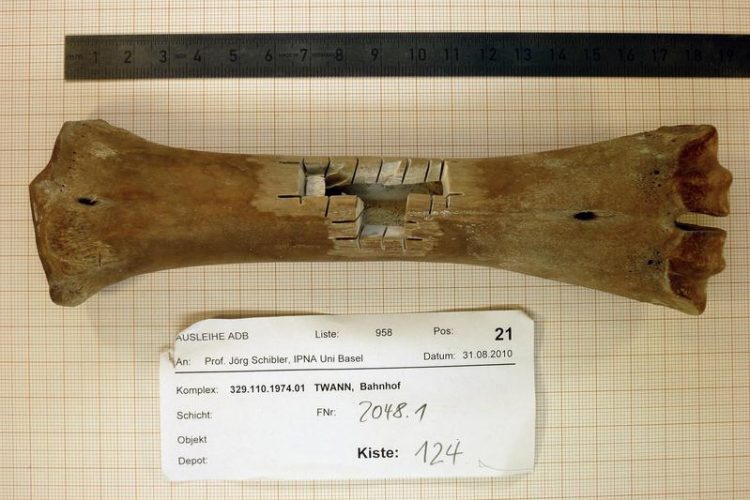DNA Find Reveals New Insights Into the History of Cattle in Europe

Metacarpus of a small and compact adult bovid found in Twann after sampling for genetic analysis. Illustration: University of Basel, Integrative Prehistory and Archaeological Science
The modern cattle is the domesticated descendant of the aurochs, a wild species that became extinct in the 17th century. The aurochs' domestication already began roughly 10,000 years ago in the Near East. It is their DNA that reveals their ancestry:
Aurochs of the Near East carry a maternally inherited genetic signature (mtDNA) called T haplogroup. Modern cattle still carry this signature and thus show that they derive from these early domesticated cattle of the Near East. This suggests that with the spreading of early farmers from the Near East to Europa, the domesticated cattle was imported to Europe alongside.
Unlike the aurochs of the Near East, the local wild aurochs of Europe belonged to the P haplogroup. So far, scientists believed that the female European aurochs did not genetically influence the Near Eastern cattle imported during the Neolithic Age (5,500 – 2,200 BC).
Small sturdy cows as draft animals
Scientists from the University of Basel by accident found a very small metacarpal bone from a Neolithic cattle among other animal bones found in the lake settlement Twann in Switzerland and analyzed its mtDNA.
The analysis showed that the bovine bone carried the European aurochs' genetic signature of the P haplogroup. The bone thus represents the first indisputable evidence that female European aurochs also crossbred with domestic cattle from the Near East.
The bone, dated to around 3,100 BC, is evidence for the earlier crossbreeding between a wild female European aurochs with a domestic bull.
“If these were coincidental single events or rather cases of intentional crossbreeding cannot be clearly answered on the basis of our results”, explains Prof. Jörg Schibler, head of the research groups for Integrative Prehistoric and Archaeological Science (IPAS) from the Department Environmental Science at the University of Basel.
The animal, to which the bone belonged, was exceptionally small with a withers height of only 112 centimeters. “This raises a number of questions for us: How difficult was copulation or birth in this case? And how many generations did it take to develop such small animals?”, explains the archaeogenetics specialist Angela Schlumbaum in regards to the significance of the discovery.
The scientists assume that the early farmers of the Horgen culture (3,400 – 2,750 BC), to which the bone dates, could have been trying to create a new smaller and sturdier type of cattle especially suitable as draft animal by intentional crossbreeding with wild aurochs. This assumption would be in accordance with archaeological finds of wooden wheels, wagons and a yoke from the Horgen culture.
Originial source
Schibler, J., Elsner, J. & Schlumbaum A.
Incorporation of aurochs into cattle hern in Neolithic Europe: single event or breeding?
Scientific Reports 4, 5798, published 23 July 2014 | doi: 10.1038/srep05798
Further information
Dr. Angela Schlumbaum, University of Basel, Department Environmental Science, phone: +41 61 201 02 18, email: Angela.Schlumbaum@unibas.ch
http://dx.doi.org/10.1038/srep05798 – Abstract
Media Contact
All latest news from the category: Life Sciences and Chemistry
Articles and reports from the Life Sciences and chemistry area deal with applied and basic research into modern biology, chemistry and human medicine.
Valuable information can be found on a range of life sciences fields including bacteriology, biochemistry, bionics, bioinformatics, biophysics, biotechnology, genetics, geobotany, human biology, marine biology, microbiology, molecular biology, cellular biology, zoology, bioinorganic chemistry, microchemistry and environmental chemistry.
Newest articles

Machine learning algorithm reveals long-theorized glass phase in crystal
Scientists have found evidence of an elusive, glassy phase of matter that emerges when a crystal’s perfect internal pattern is disrupted. X-ray technology and machine learning converge to shed light…

Mapping plant functional diversity from space
HKU ecologists revolutionize ecosystem monitoring with novel field-satellite integration. An international team of researchers, led by Professor Jin WU from the School of Biological Sciences at The University of Hong…

Inverters with constant full load capability
…enable an increase in the performance of electric drives. Overheating components significantly limit the performance of drivetrains in electric vehicles. Inverters in particular are subject to a high thermal load,…





















